
Peter Stehlik
The de Blasio administration announced on Thursday a contract deal with union representing firefighters that settles disputes over pay and disability benefits. It also addresses how many people ride on fire engines.
Let’s oversimplify drastically: Fire departments largely divide their staffing between ladder companies, which ride trucks and effect rescues, and engine companies, which ride engines and apply water to put out the flames.
For a long time, the city and the fire union have disagreed over how many people should staff a fire engine. The union would prefer five people, the city four.
On a fire company, everyone has a specific job. Ladder companies, for instance, have a Chauffeur (driver), Roof (whose main job is to head to the roof to cut ventilation holes and assist with rescues), Outside Ventilation (makes ventilation holes from the outside), Irons (carries rescue tools) and Can (carries a fire extinguisher). An officer is in charge of the outfit.
Engine companies also have an officer and a Chauffeur. They are joined by a Nozzle (controls the hose), Backup (helps the nozzle) and Control (hooks up to the hydrant). On five-man engine companies, there is also a Door firefighter who helps bracing doors open and in positioning the hoses.
Today’s labor deal means “the FDNY will staff 20 Engine Companies with five firefighters each by February 2019, adding the fifth firefighter to five companies each year beginning in 2016.” The city and unions will share the costs.
In 2011, City Limits investigated 20 years of firefighter fatalities and the FDNY’s safety record. For background, here’s the section on the four-versus-five dispute:
For more than three decades, firefighters and the city have been arguing over how many firefighters are needed on an engine company. Should an officer have four people or five to position the engine, hook up to the hydrant, connect hose lengths, stretch the hose up to the fire and control the application of water?
The city moved in 2009 moved to reduce 49 companies back to four firefighters. In late 2010 it aimed for and won the reduction for all 60 remaining five-firefighter engine companies, saving the department $20 million a year.
At a May budget hearing, FDNY commissioner Salvatore Cassano was asked if the transition to a city-wide policy of only four firefighters per engine has made an impact on safety. He insisted it hasn’t. Cassano’s predecessor Scoppetta says the five-versus-four debate is mainly about getting firefighters enough overtime.
But in 1987 then-deputy chief Vincent Dunn conducted an unofficial test on Randall’s Island to see how much longer it took a four-firefighter team than a five-firefighter team to stretch a hose. Getting a hose to the fifth floor took the four-firefighter team 10 minutes, 23 seconds. It took a five-firefighter team just under six minutes. Going to the sixth floor took the smaller crew four minutes longer than it took the larger crew.
Dunn’s test, Scoppetta said, was too limited. “You really have to do a more controlled set of tests to see what the difference is,” he said. “There are many fire departments that operate with three firefighters.” While some fire departments do operate three-person engines—Houston’s does—national standards call for at least four, which is what Chicago generally uses, and the National Fire Protection Administration has written that “progressive” fire chiefs believe five is the minimum.
The FDNY never conducted a more rigorous duplication of Dunn’s test during Scoppetta’s eight years at its helm or at any time since 1987. New York firefighters insist that losing the fifth firefighter makes a huge difference. Stretching a hose sounds simple to those of us whose hose operations consist of wetting down the tomatoes in the backyard. But, as Al Turi explains, it’s not easy. “The hose is heavy. It gets snagged on things,” he says. “It seems simple, but it takes a tremendous amount of work to do it in a fluid motion so it doesn’t get kinked.” And to do it fast.
Indeed, FDNY policy implicitly admits the impact of the staffing change by requiring that four-firefighter engine companies wait for a second engine before stretching a hose line. The department says this policy hasn’t resulted in problems at fires. But union officials say the number of injuries to firefighters is up 30 percent this year over last, despite a 3.7 percent decrease in the number of structural fires.








2 thoughts on “City Pact with FDNY Union Addresses Longstanding Staffing Issue”
The city should have to pay for all 20! This is a crap deal.
Houston staffs 4 on all engines as well as trucks. Getting 4 on every pumper only happened after a Captain was killed at a residential high rise fire with sub par staffing.
The widow publically called out and shamed the administration.